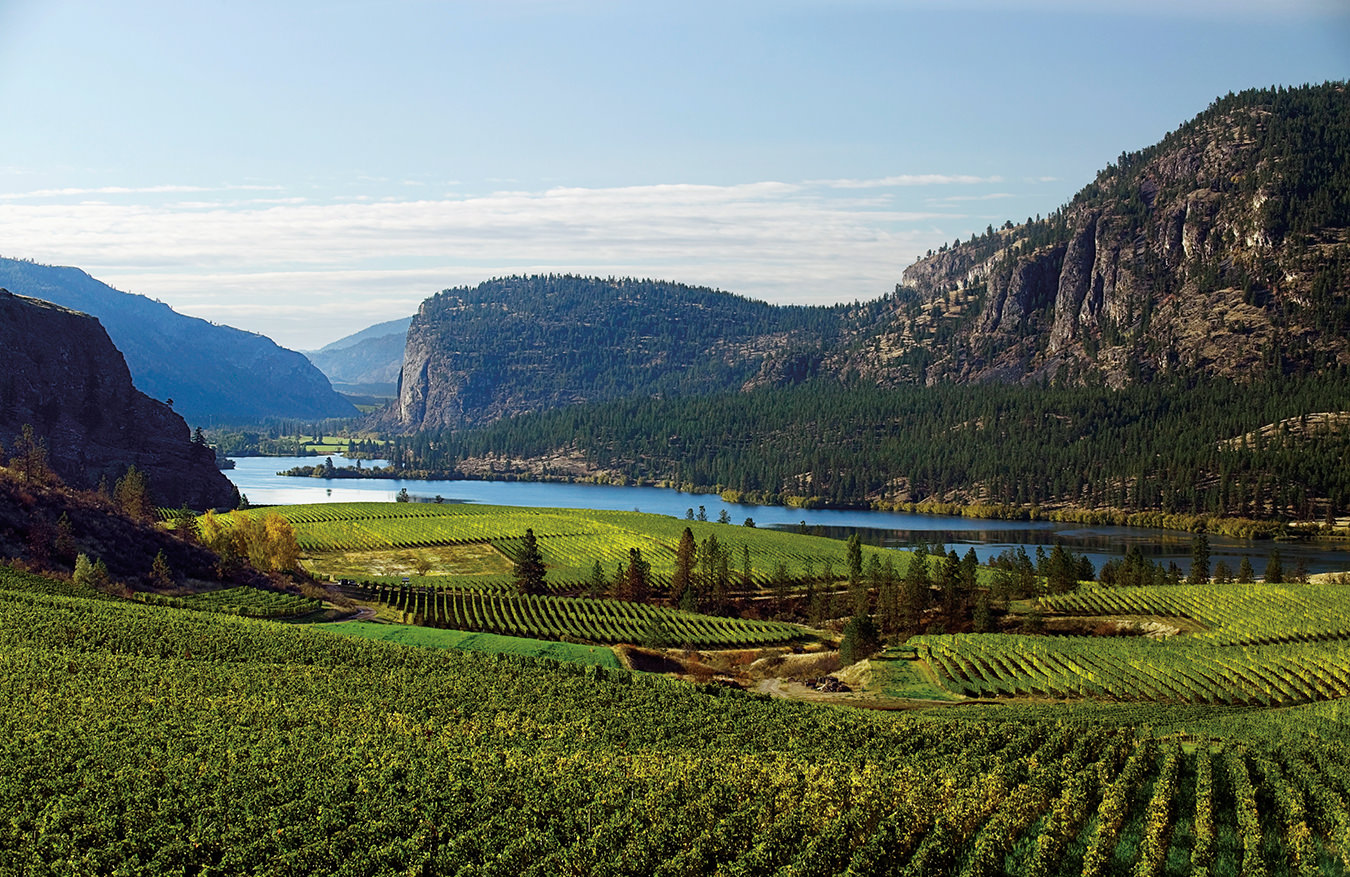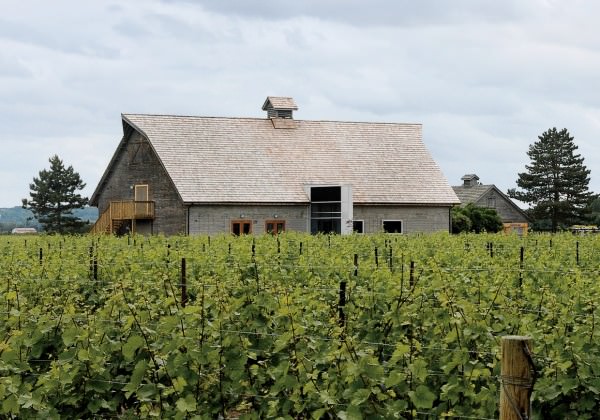The Wonders of Pink Wine
Rosé-coloured glasses.

Vineyards frame Vaseux Lake and McIntyre Bluff in British Columbia's Okanagan Valley. Photo ©Kevin Miller.
In the world of wine, pink might not be the new black, but quality rosé wines are on a roll. Even though pink wines will never challenge whites and reds in popularity, they are shedding their image as sweet and suitable only for people who don’t really like wine. A new generation of rosés—made in drier and balanced styles, with careful attention to grape varieties—is being embraced by wine drinkers of all demographics.
It’s the latest phase in the peculiar history of rosé wine. Until the last hundred or so years, most rosés were unplanned field blends—blends of the varieties that just happened to be in the vineyard, rather than being carefully assembled by the winemaker. The colour of a wine from a field blend depended on the colour of the grapes: the more black grapes, the darker the wine, because it is the pigments in the black skins that give red wine its colour. So wines ranged from white to dark red, with many shades of pink and red in between.
Only a few regions set out to make rosé wines. One was Champagne, where the sparkling wine was originally made into a light pink-brown hue called oeil de perdrix, or “partridge eye”. But in the mid-1800s, champagne houses started to make it white, and the few that produced a rosé version made it in a more definitive pink. The only significant European region to specialize in rosé wine as we know it was Tavel, in Provence, now the only French appellation to make nothing but rosé wine. But although Tavel is prestigious and sometimes expensive, until quite recently it was considered, essentially, a mediocre wine.
A generally dismissive (and often negative) view of rosé was given a gender twist when New World producers began to make rosé wine in sweeter styles marketed specifically to women. Most men would no more hold a glass of pink wine than wear pink trousers, and they wrote off rosé as a frivolous “woman’s wine”, not to be taken seriously. Rosé still has a gendered image: there is always a rosé in the brands directed toward women (like Girls’ Night Out, Little Black Dress, and Be), but never in those that are marketed to men (like Sledgehammer).
The bestselling pink wine in North America is white zinfandel—called “white” because when California’s Sutter Home Winery first made it in the early 1970s, it was too pale to be called “pink”. In 1975, a batch of this wine “stuck” during fermentation, meaning the yeasts died before consuming all the sugar in the grape juice. The result—unintentional, in the best tradition of rosé winemaking—was sweet and pink. It wasn’t only the fermentation that stuck; so did the name. When Sutter Home failed to persuade American wine authorities to accept oeil de perdrix as a label term, they reverted to “white zinfandel”, despite the colour.
That ruling probably did the winery a favour. “Oeil de perdrix zinfandel” hardly slips off the tongue, but “white zin” took the American market by storm. Soon, other producers jumped on the pink wagon. Sales of white zinfandel in the United States peaked in 2000, when 260 million bottles were sold, and have since declined to about 200 million bottles—almost 10 per cent of all California wine. It’s not that fans of white zin are seeking drier rosés; instead, they seem to be migrating from this faux white to a real white, moscato, which has a level of sweetness similar to many of the white zinfandels.
Against this trend, there has been a steady increase in the consumption of rosé wine in Canada. The value of rosés sold in Ontario’s LCBO stores, for example, increased from $30-million to $35-million between 2008 and 2011; in Quebec’s SAQ stores, it increased from $61-million to $73-million between 2008 and 2010. Canada’s wine producers responded to demand by increasing their production of pink wine. Ontario produced 63 still and sparkling rosé wines in 2009, and 79 a year later, and the total production of rosé leapt by a remarkable 50 per cent. Inniskillin, one of Ontario’s largest wineries, ramped up its pinot noir rosé from 3,000 bottles in 2008 to more than 16,000 bottles in 2011.
The new generation of Canadian rosés is predominantly dry, balanced, and carefully focused on varieties selected for their performance in the country’s different wine regions. Because they are most often drunk in the summer, many rosés tend to be refreshing, and acidity is the trait winemakers refer to most often as they describe their rosés. Mason Spink, winemaker at British Columbia’s See Ya Later Ranch, says, “We try for a lifted fruity nose along with a good acid backbone, which allows our rosé to pair well with many foods.” This style leads many winemakers toward varieties with higher natural acid levels. Inniskillin’s Bruce Nicholson has been successful with pinot noir, while Gina Haverstock, winemaker at Nova Scotia’s Gaspereau Vineyards, uses a hybrid called Lucie Kuhlmann. Mason Spink goes for gamay and pinot noir.
Yet others prefer weightier styles of rosé. Ann Sperling, who makes the wine at Niagara’s Southbrook Vineyards, was influenced by the rosé wines of France’s Loire Valley. “I am happy to work entirely with cabernet franc,” she says. “However, a small percentage of cabernet sauvignon can add depth, and a drop of syrah provides personality. I’ve never been taken by the more restrained rosés of Tavel and Provence, so I work to bring out the most intense aromatics.”
The greater attention now being given to rosé means that grapes are cultivated specifically for the wines. It used to be said that in a poor Canadian vintage, when the red wines were destined to be thin and acidic, we could expect increased production of rosé wine. But the new breed of rosé is not a failed red; it’s a quality style in its own right. Daniel Speck, one of the brothers who own Niagara’s Henry of Pelham Family Estate Winery, puts it this way: “As with any wine we make, we grow the fruit for the specific wine. We select a vineyard and cultivate it with rosé in mind. This is not the easiest way to make this wine—we could simply siphon off pink wine from our red production early on, for example, but then we wouldn’t get the same result.”
Everyone agrees that the colour of rosé wine is important, and Canadian rosés show a real spectrum of pinks, from light salmon to hues so vibrant they would not be out of place on a crossing guard’s vest. Daniel Speck says colour “is hugely important—we drink as much with our eyes as we do with our mouth. At our winery, we’ve chosen to go for an electric pink colour that really pops, and is suggestive of what the wine will taste like.” Bruce Nicholson, winemaker at Inniskillin, says he likes his rosés to be “inviting”, but not so dark that they could be confused with red wine, or so light that they might seem delicate in body and flavour.
An alternative view comes from See Ya Later’s Mason Spink: “We try to achieve what I call a ‘serious’ rosé … If you look at a glass of rosé that is pale with orange hues, you will most likely think it will be simple, boring wine even before tasting it. I try to achieve a rich, intense colour in our rosé—but that being said, I have been criticized for making a rosé that is too dark.”
Colour can be a guide to style: a rosé that is darker because of longer contact with skins is likely to have more complexity and developed tannins. Examples are 13th Street’s 2010 Cabernet Rosé from Niagara, a big rosé closer to red in colour, with depth and breadth of flavour, and Inniskillin’s 2010 Pinot Noir Rosé, which is complex with fine tannins. Lighter-hued rosés are often easier-drinking, but paler colour can also reflect a grape with less-intense skin pigmentation. For example, Angels Gate 2010 Rosé from Niagara surrenders nothing to complexity and flavour, but owes its bronze-salmon colour to a short period of contact with the skins of the gamay, pinot noir, and cabernet franc grapes it’s made from.
There are also variants from the dominant new style. Gaspereau Vineyards’ 2010 Rosé, a quite deep pink from the pigment of the Lucie Kuhlmann skins, carries some sweetness, but it’s well balanced by the acidity that this variety produces. Other Canadian wineries are making sparkling rosé wines, while some of the icewines made from black grapes, like cabernet franc, look more rosé than red.
It’s clear that rosé wine, which is now made all over the world as carefully as reds and whites, should be taken seriously. Like red and white wines, there are unbalanced and poorly made rosés. But there is now a critical mass of rosés made from selected varieties, in dedicated vineyards, in styles with balance and structure. As more and more wine lovers are appreciating, rosé wine is not white wine pretending to be red, or red wine for novices, but a distinctive and serious style in its own right.
Originally posted May 28, 2012.
Top photo ©Kevin Miller.





